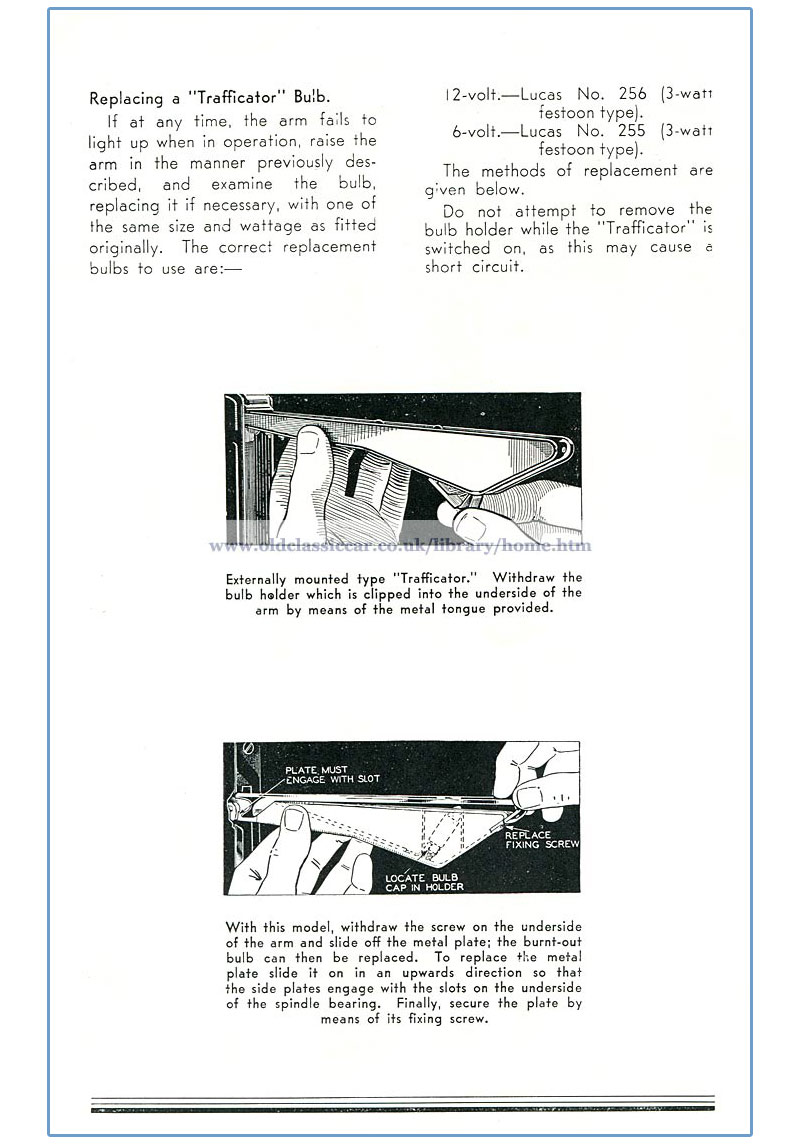
|
Trafficators (semaphore indicators).
In the 1930s, Lucas published a booklet titled "Electricalities", giving advice and maintenance tips on the many varied electrical components that they produced. Lucas components were used in hundreds of thousands of British cars, and can usually be found somewhere in cars preserved to this day. In the days before flashing indicators, motorists wishing to make their turning intentions known, would either use hand signals, or if their car was thus equipped, pop-up trafficators, or semaphore indicators as they're often also known. Other companies also made their own versions, for example Tex, but the basic principles of operation and care apply to most types.
|
|
Trafficators were common fitments on cars built in the 1930s, right through to the late 1950s. Common problems include them refusing to "pop up", and if they do rise to the occasion, refusing to illuminate. Cars built with these semaphore-type turn signals as standard, often had them built flush into the car's coachwork. This is a neater arrangement, but makes servicing the units slightly more involved, as accessing them usually requires trim to be removed inside the car. Cars that were fitted with aftermarket indicators, usually had standalone boxes incorporating the signal mechanisms bolted to their scuttle ahead of the front doors, or sometimes to the B pillars behind the doors. Commercial vehicles usually have externally-mounted trafficators also, often being situated just behind the cab. This arrangement is a lot simpler to work on, but is also more exposed to the elements so probably needs more in the way of servicing and maintenance, than the flush units.
|
|
One downside of pop-up turn signals is that they're not always that easy to spot by other road users, especially in poor weather. One improvement was marketed by Creators Ltd, and sold under the Plansel name. Basically this enabled traditional trafficator units to display flashing signals. More information on this variation may be found on this page, within the accessories and gadgets section here at OCC.
|
|
A couple of pages within "Electricalities" describe some of the common servicing requirements that trafficators tend to require. These are shown below.
|
|
Return to the OCC Reference Library section.
|
|
Electricalities - Looking After Your Trafficators.
- Published by Joseph Lucas Ltd, Birmingham, England.
- Date: 1930s.
|
|
Lubrication.

|
Replacing a bulb.

|
|
Please note.
Information presented in this section is provided as an aid to classic and vintage car owners only. It shouldn't necessarily be taken as gospel, more of a useful series of pointers. It may be that since these period instructions were created, better ways have since evolved to tackle work on the components being considered. Tips and advice may be given in these period articles, but inclusion doesn't necessarily suggest that anyone involved with OCC endorses the methods portrayed. A certain level of mechanical know-how will be required in undertaking work as described in these pages, and anyone unsure of their own abilities is advised to seek further assistance. Delve into your car's inner workings only if you feel confident in your own abilities, after all - a little knowledge can be dangerous, as the old saying goes.
|
|
No-one at OCC can be held responsible for breakages and injuries that might occur, while working on a vehicle following a read of pages hosted on the site. Dabble at your own risk. Where possible, the source(s) for the data shown will be given. If the accreditations are incorrect, or contravene your copyright, please let me know.
|
|
Return to the OCC Reference Library section.
|







